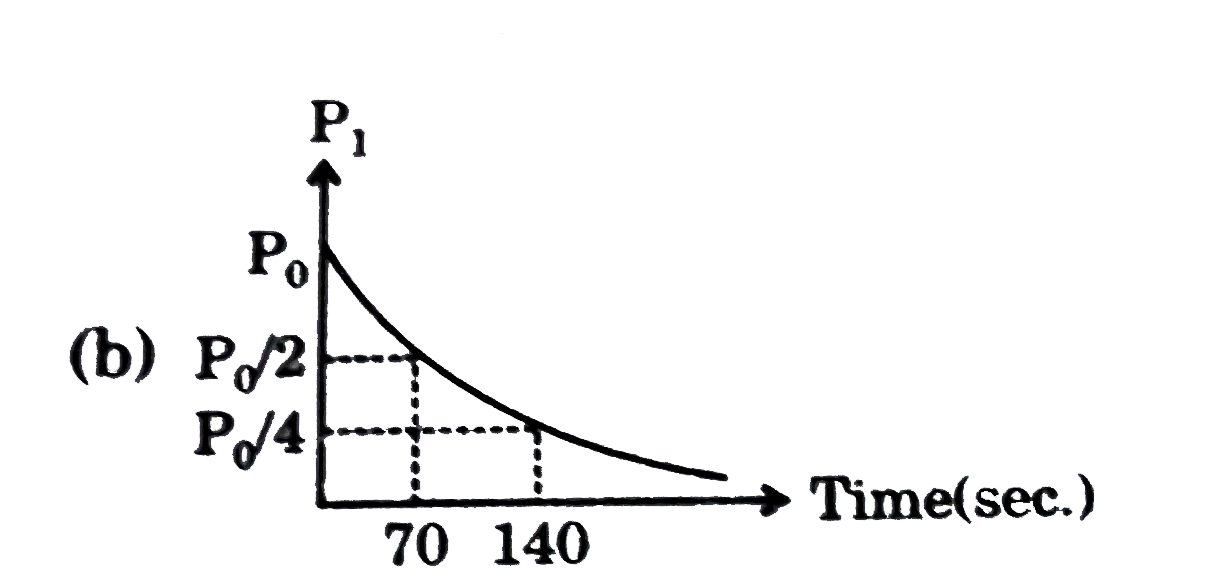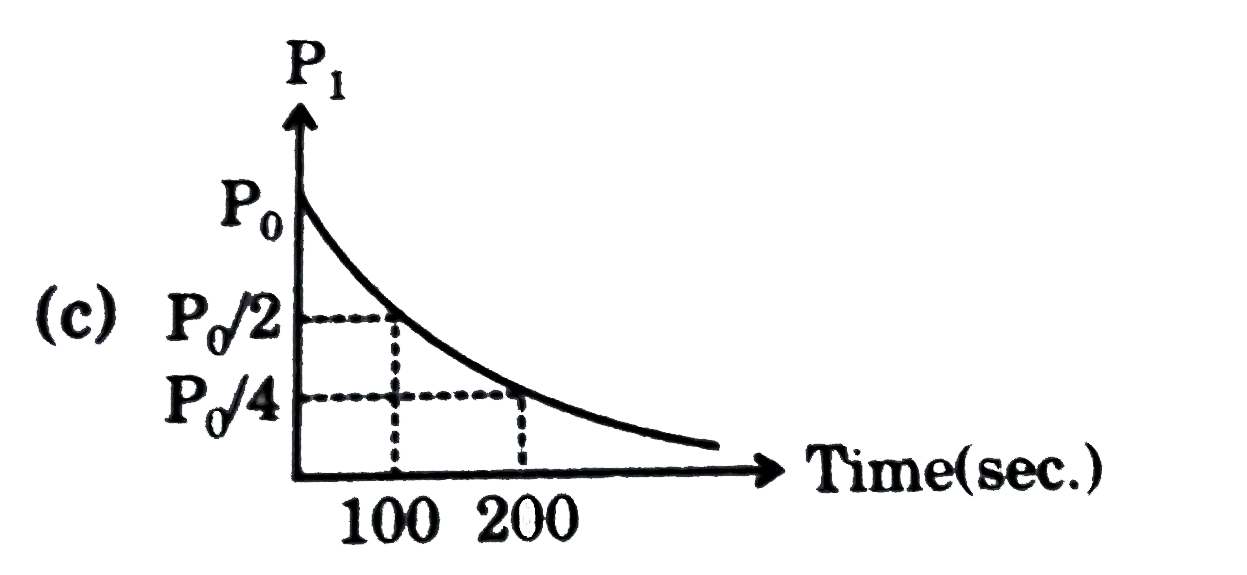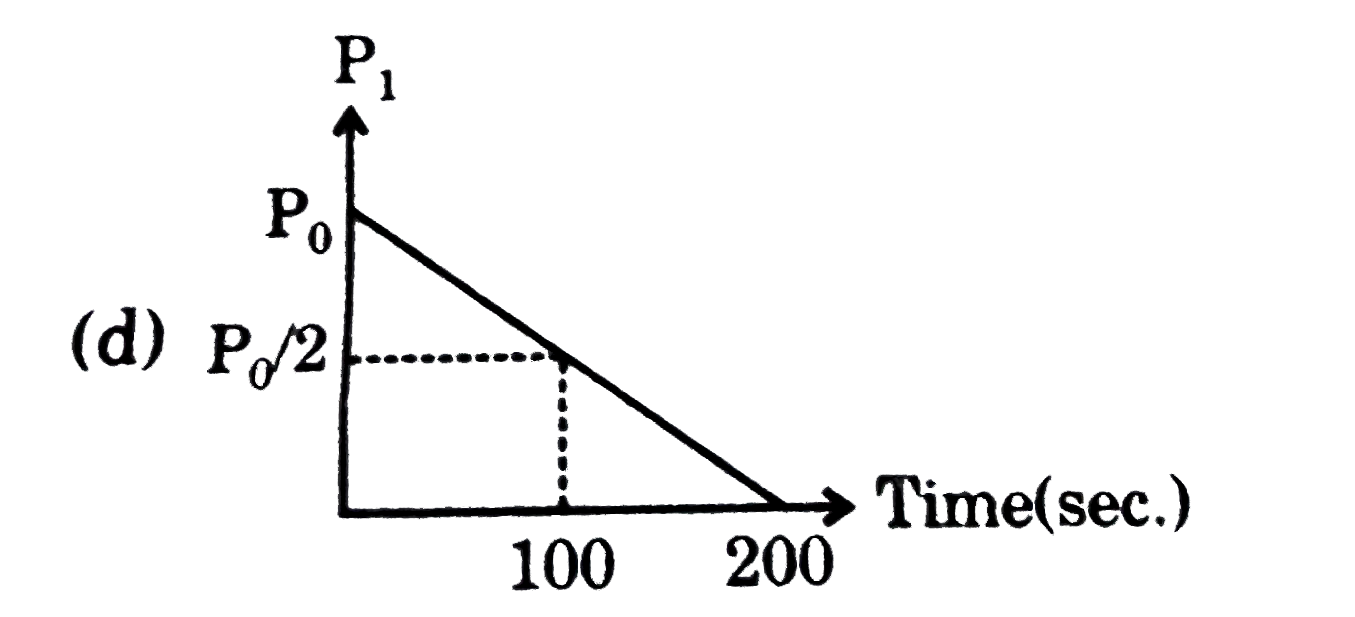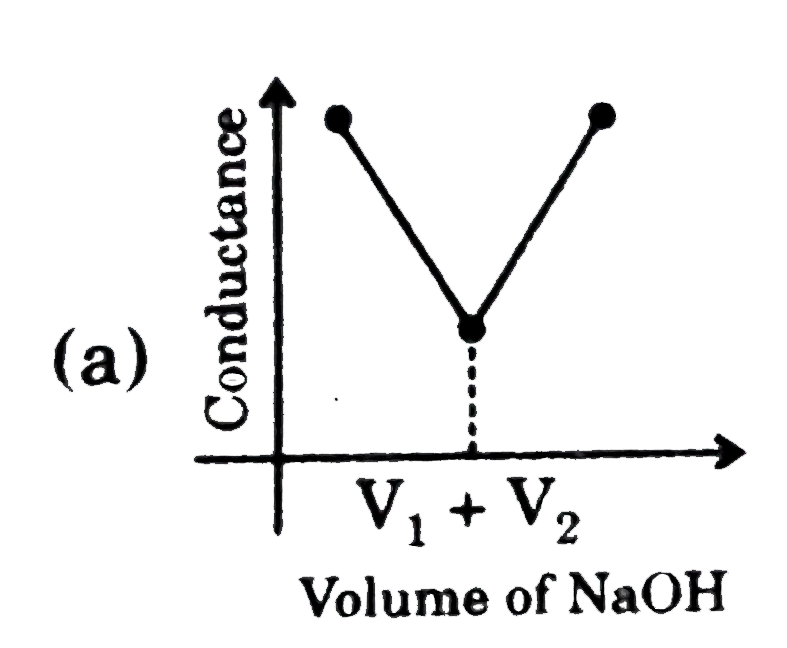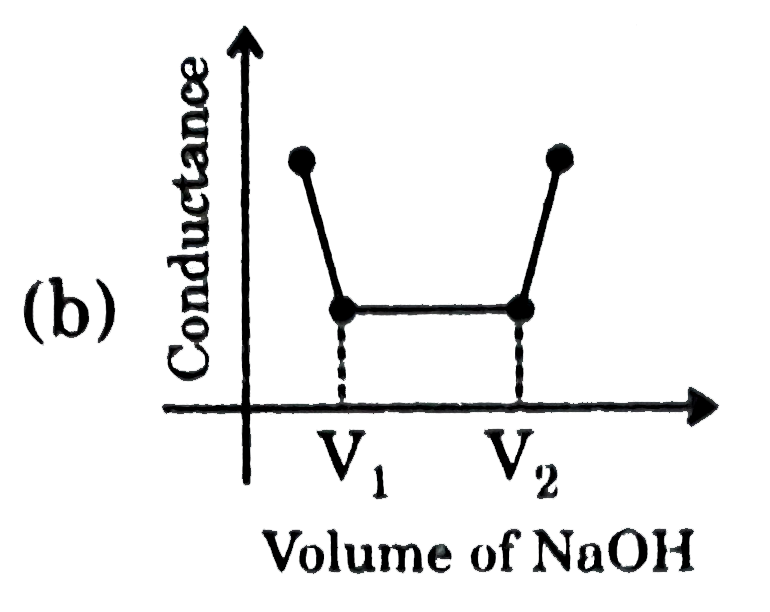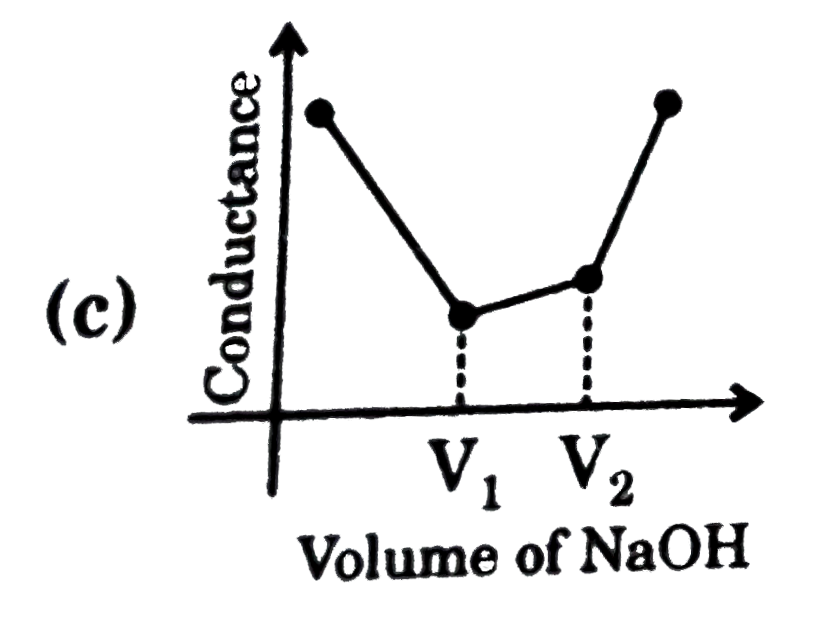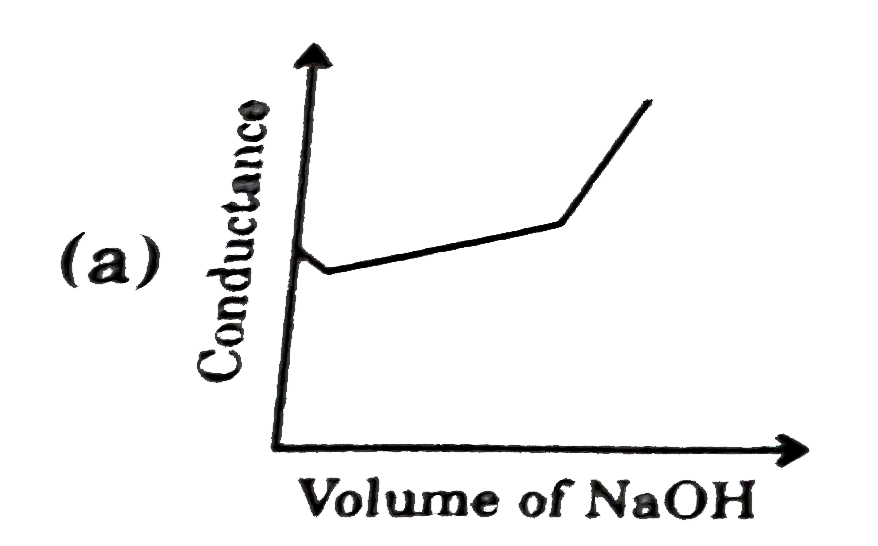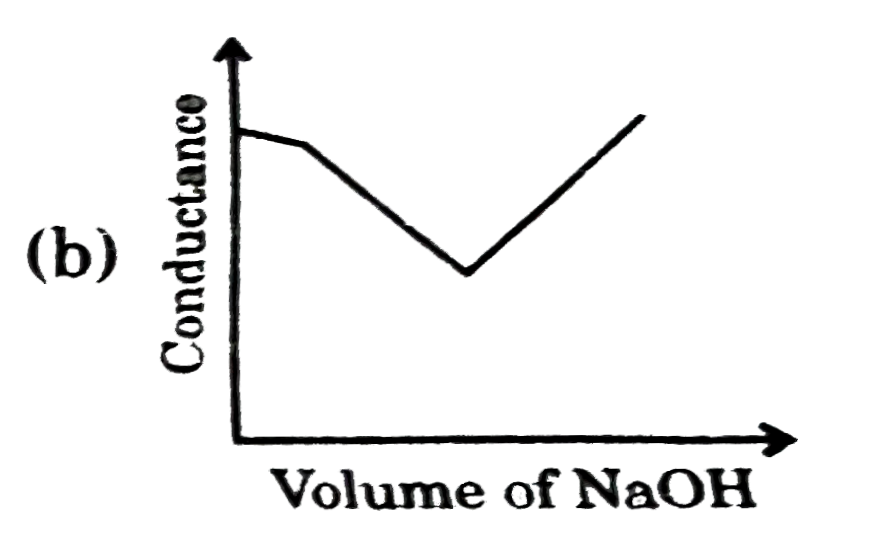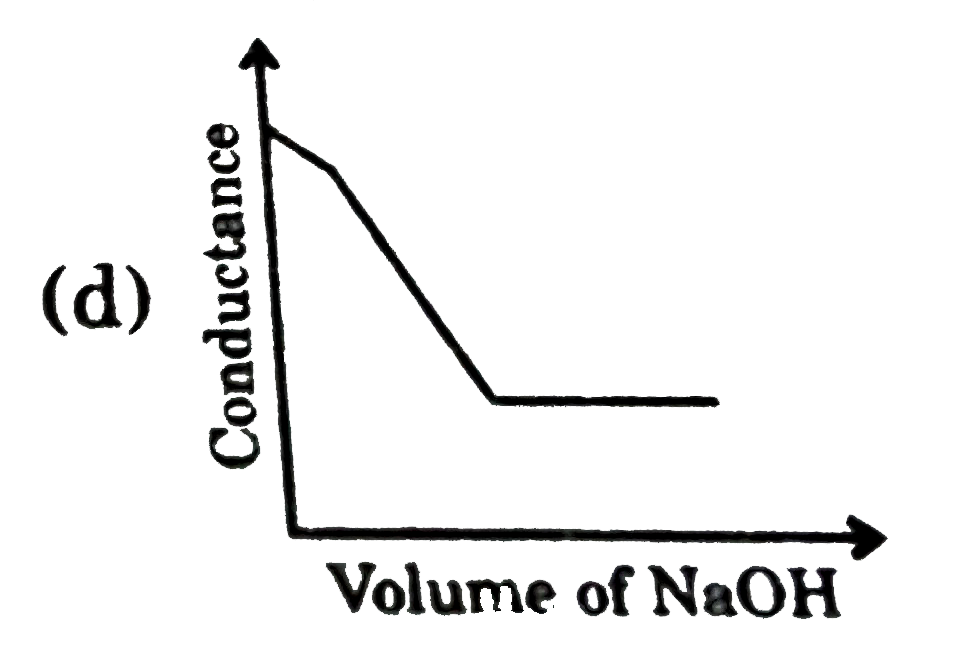Explore topic-wise InterviewSolutions in .
This section includes InterviewSolutions, each offering curated multiple-choice questions to sharpen your knowledge and support exam preparation. Choose a topic below to get started.
| 25501. |
The process by which a gas through a small hole into vacuum is called effusion. The rate of change of pressure (p) of a gas at constant temperature due to effusion of gas from a vessel of constant volume can be related to rate of change of number of molecules by the expression: (dp)/(dt)=(kT)/(V)((dN)/(dt)) where Rate ofchange of number of molecules rArr""-(dN)/(dt)=(pA_(0))/((2pimkR)^(1//2)) where, k= Boltzmann constant N_(A) = Avogadro's number T= temperature (in K) rArr""-(dN)/(dt)=(pA_(0))/((2pimkR)^(1//2)) N_(A) = Avogadro's number T=temperature (in K) V=volume of vessel N=1 no.of molecules A_(0)= area of aperture m=mass of single molecule gamma=(V)/(A_(0))sqrt((2pim)/(kT)) If under any conditions gamma=100 sec then select the correct graph of pressure of gas at any time (P_(t)) us Time (t). [Given : In 2=0.7] |
|
Answer»
|
|
| 25502. |
The process by which vegetable ghee is manufactured known as: |
|
Answer» SAPONIFICATION |
|
| 25503. |
The process by which a gas through a small hole into vacuum is called effusion. The rate of change of pressure (p) of a gas at constant temperature due to effusion of gas from a vessel of constant volume can be related to rate of change of number of molecules by the expression: (dp)/(dt)=(kT)/(V)((dN)/(dt)) where Rate ofchange of number of molecules rArr""-(dN)/(dt)=(pA_(0))/((2pimkR)^(1//2)) where, k= Boltzmann constant N_(A) = Avogadro's number T= temperature (in K) rArr""-(dN)/(dt)=(pA_(0))/((2pimkR)^(1//2)) N_(A) = Avogadro's number T=temperature (in K) V=volume of vessel N=1 no.of molecules A_(0)= area of aperture m=mass of single molecule gamma=(V)/(A_(0))sqrt((2pim)/(kT)) If initial pressure is P_(0) then pressure of gas at any time t in the container at constant V and T is given by: |
|
Answer» <P>`P_(0)E^(-t//y)` |
|
| 25504. |
The process by which synthesis of protein takes place based on the genetic information present in m-RNA is called |
|
Answer» TRANSLATION |
|
| 25505. |
The process associated with the manufacture sodium carbonate is known as: |
|
Answer» Chamber |
|
| 25506. |
The process of zone refining is used for |
|
Answer» Sillicon |
|
| 25507. |
The process in which ore is heated in air below its melting point is known as : |
|
Answer» ROASTING |
|
| 25508. |
The probable formula for prussian blue is : |
|
Answer» `Fe_3[Fe(CN)_6]_2` |
|
| 25509. |
The probability of finding the electron in P_(x) orbital is |
|
Answer» maximum on two OPPOSITE sides of the NUCLEUS along X-axis |
|
| 25510. |
The prinicipal constituent of superphosphate of lime is |
|
Answer» `Ca_3(PO_4)_2` |
|
| 25511. |
The principle on conductometric titration is based in the fact that during the titration, one of the ions is replaced by the otherand invariably thses two ions differ in the ionicconductivity with the result that the conductivity of the solution varies during the course of the titration.Take,for example,the titration between strong acid, say HCl. and a strong base, say NaOH.Before NaOH is added the conuctance of HCl solution has a high value due ti the persence if highly hydrogen ions.As NaOH is added,H^(+) ions are the replaced by relatively slower moving Na^(+) ions.Consequently, the conductance of the solution decrease and this continues right upto the enuivalence point where the solution contains only NaCL.Beyond the equivalence point if more of NaOH is added, then the solution contains an excess of the fast moving OH^(-) with the result that its as more of NaoH added, we plot the conductance value vs the amount of NaOH added we get curve of the type shown in figure.The descending portion AB represents the conductance before the equivalence point (solution cintains a mixture if acid HCl and the salt NaCL and the ascending portion CD represents the conductances after the equivalence point (solution contains the salt NaCL and the excess of NaOH). The point E which repersents only the minimum conductance is alkali and thus repersents the equivalence point.This point can, however, be obtained by the extrapoltion of the lines AB and CD and therefore one is not very particular in location this point experimentally as it is in the case of ordinary acid -base involving the acid base indicators LET us take the specific exaanple of acetic acid being titration against NaOH.Before the addition the of alkali, the solution shows poor conductance due to feeble inization of acetic acid.Initially the addtion of alkali causes not only the replacement of H^(+) by Na^(+) but also suppresses the thus the conductance of the solution decrease in the begnning .But very soon the conductance starts increasing as addetion NaOH thus causing neutralizes the undissociated HAc to HAc with strong condutance eletroyte Na^(+)Ac^(-).The increase in conducting OH^(-) ions gtthe graph near the highly equivalence point actual equivalence point can as usual be ontained by the extrapoiation method In all thses graphs it been assumed that the vloume change due additionof solution from burette in negligible heane vloume changeof the sloution in beaker the conuctance of which is measured is almost constant throughout the measurement If a 100 ml solution of 0.1 MHBr is titration using a very concentrated solution of NaOH then the conductivity (specific conductance0 of this solution at the equivalence wil be (assume volume change is negligible due addition of NaOH). Report your answer after mulitiplyingit with 100 inSm^(-1) [Given : lambda_((Na^(+)))^(@)=8xx10^(-3)Sm^(2)mol^(-1), lambda_((Br^(-)))^(@) = 4 xx 10^(-3) Sm^(2)mol^(-1)] |
|
Answer» 6 |
|
| 25512. |
The principle on conductometric titration is based in the fact that during the titration, one of the ions is replaced by the otherand invariably thses two ions differ in the ionicconductivity with the result that the conductivity of the solution varies during the course of the titration.Take,for example,the titration between strong acid, say HCl. and a strong base, say NaOH.Before NaOH is added the conuctance of HCl solution has a high value due ti the persence if highly hydrogen ions.As NaOH is added,H^(+) ions are the replaced by relatively slower moving Na^(+) ions.Consequently, the conductance of the solution decrease and this continues right upto the enuivalence point where the solution contains only NaCL.Beyond the equivalence point if more of NaOH is added, then the solution contains an excess of the fast moving OH^(-) with the result that its as more of NaoH added, we plot the conductance value vs the amount of NaOH added we get curve of the type shown in figure.The descending portion AB represents the conductance before the equivalence point (solution cintains a mixture if acid HCl and the salt NaCL and the ascending portion CD represents the conductances after the equivalence point (solution contains the salt NaCL and the excess of NaOH). The point E which repersents only the minimum conductance is alkali and thus repersents the equivalence point.This point can, however, be obtained by the extrapoltion of the lines AB and CD and therefore one is not very particular in location this point experimentally as it is in the case of ordinary acid -base involving the acid base indicators LET us take the specific exaanple of acetic acid being titration against NaOH.Before the addition the of alkali, the solution shows poor conductance due to feeble inization of acetic acid.Initially the addtion of alkali causes not only the replacement of H^(+) by Na^(+) but also suppresses the thus the conductance of the solution decrease in the begnning .But very soon the conductance starts increasing as addetion NaOH thus causing neutralizes the undissociated HAc to HAc with strong condutance eletroyte Na^(+)Ac^(-).The increase in conducting OH^(-) ions gtthe graph near the highly equivalence point actual equivalence point can as usual be ontained by the extrapoiation method In all thses graphs it been assumed that the vloume change due additionof solution from burette in negligible heane vloume changeof the sloution in beaker the conuctance of which is measured is almost constant throughout the measurement Themost appropriate titration curve ibtained when a mixture of a strong acid (say HCl) and a weak acid (sayCH_(3)COOH0 is titration with (say NaOH) will be |
|
Answer»
|
|
| 25513. |
The principle on conductometric titration is based in the fact that during the titration, one of the ions is replaced by the otherand invariably thses two ions differ in the ionicconductivity with the result that the conductivity of the solution varies during the course of the titration.Take,for example,the titration between strong acid, say HCl. and a strong base, say NaOH.Before NaOH is added the conuctance of HCl solution has a high value due ti the persence if highly hydrogen ions.As NaOH is added,H^(+) ions are the replaced by relatively slower moving Na^(+) ions.Consequently, the conductance of the solution decrease and this continues right upto the enuivalence point where the solution contains only NaCL.Beyond the equivalence point if more of NaOH is added, then the solution contains an excess of the fast moving OH^(-) with the result that its as more of NaoH added, we plot the conductance value vs the amount of NaOH added we get curve of the type shown in figure.The descending portion AB represents the conductance before the equivalence point (solution cintains a mixture if acid HCl and the salt NaCL and the ascending portion CD represents the conductances after the equivalence point (solution contains the salt NaCL and the excess of NaOH). The point E which repersents only the minimum conductance is alkali and thus repersents the equivalence point.This point can, however, be obtained by the extrapoltion of the lines AB and CD and therefore one is not very particular in location this point experimentally as it is in the case of ordinary acid -base involving the acid base indicators LET us take the specific exaanple of acetic acid being titration against NaOH.Before the addition the of alkali, the solution shows poor conductance due to feeble inization of acetic acid.Initially the addtion of alkali causes not only the replacement of H^(+) by Na^(+) but also suppresses the thus the conductance of the solution decrease in the begnning .But very soon the conductance starts increasing as addetion NaOH thus causing neutralizes the undissociated HAc to HAc with strong condutance eletroyte Na^(+)Ac^(-).The increase in conducting OH^(-) ions gtthe graph near the highly equivalence point actual equivalence point can as usual be ontained by the extrapoiation method In all thses graphs it been assumed that the vloume change due additionof solution from burette in negligible heane vloume changeof the sloution in beaker the conuctance of which is measured is almost constant throughout the measurement the nature of curve obtained for the titration between weak acid vs strong base as described in the above will be |
|
Answer»
|
|
| 25514. |
The principle which gives a way to fill the electrons in the available energy level is: |
|
Answer» HUND's rule |
|
| 25515. |
The principle of cleaning by soap is |
|
Answer» surface tension |
|
| 25516. |
The principle involved in zone refining method is that _______. |
|
Answer» IMPURITIES of low boiling metals can be seperated by distillation |
|
| 25517. |
The principle behind the acidity order Cl_3C COOH > Cl_2CHCOOH > CH_3COOH is the withdrawal of electrons and liberation of protons is due to which effect? |
|
Answer» |
|
| 25518. |
The principal source of helium is: |
|
Answer» Air |
|
| 25519. |
The principal reducing agent in the metallurgy of iron is ___________. |
|
Answer» ALUMINIUM |
|
| 25520. |
The principal reaction in the zone of fusion of blast furnace employed in the metallurgy of iron is |
|
Answer» `C+O_(2) to CO_(2)` |
|
| 25521. |
The principal reaction in the zone of heat absorption of blast furnace employed in the metallurgy of iron is |
|
Answer» `2C + O_(2) to CO` |
|
| 25522. |
The principal products obtained on heating iodine with concentrated caustic soda solution are: |
|
Answer» NAOI + NAI |
|
| 25523. |
The principal organic compound formed in the reaction CH_2=CH(CH_2)_8COOH+HBroverset("Peroxide")rarr............ is |
|
Answer» `(CH_3)_8COOH` HENCE, (C) is the correct answer. |
|
| 25525. |
The principal hormone responsible for development of female characteristics in controlling of menstrual cycle is……………………. |
|
Answer» PROGESTERONE |
|
| 25526. |
The principal gas evolved from sludge digestion tank is : |
|
Answer» CO |
|
| 25527. |
The primary valency of iron in K_(4)[Fe(CN)_(6)] is : |
|
Answer» 2 |
|
| 25528. |
The principal buffer present in the blood is: |
|
Answer» `CH_3COONH_4` |
|
| 25529. |
The principal buffer present in human blood |
|
Answer» `NaH_(2)PO_(4) + Na_(2)HPO_(4)` |
|
| 25530. |
The primary valency of the metal ion in the co-ordination compound, K_2[Ni(CN)_4] is |
|
Answer» Four |
|
| 25531. |
The primary valency of Iron in K_(4)[Fe(CN)_(6)] is satisfied by |
|
Answer» Six `CN^(-)` IONS |
|
| 25532. |
The primary valency of the central transition metal ion in a complex compound (Cr(NH_(3))_(4)Cl_(2)]Cl |
|
Answer» 3 |
|
| 25533. |
The primary valency of 'Fe' in the complex K_(4)[Fe(CN)_(6)] is |
|
Answer» 2 |
|
| 25534. |
The primary test to check the sol is colloid or not is… |
|
Answer» by the motion of PARTICLES. |
|
| 25535. |
The primary valency of Fe in K_3[Fe(CN)_6] is |
|
Answer» 3 |
|
| 25536. |
The primary structure of a protein tells about |
|
Answer» 3D ARRANGEMENT of all atoms |
|
| 25537. |
The primary standard solution for estimation of Na_(2)S_(2)O_(3) is |
|
Answer» `I_(2)` solution |
|
| 25538. |
The primary structure of a protein refers to |
|
Answer» `ALPHA `-helical backbone |
|
| 25539. |
The primary products of photosynthesis in green plants . It contains the element |
|
Answer» Fructose |
|
| 25540. |
The primary pollutant that leads to photochemical smog is : |
|
Answer» nitrogen oxides |
|
| 25541. |
The primary and secondary valencies of chromium in the complex ion, dichloro-dioxalatochromium (III) are respectively |
|
Answer» 3, 4 |
|
| 25542. |
The primary and secondary valencies of the central metal ion in the complex [Co(NH_(3))_(6)]Cl_(3) respectively are |
| Answer» Answer :D | |
| 25543. |
The primary bateries are ……………. . |
|
Answer» RECHARGEABLE |
|
| 25545. |
The pri., sec. and ter.amines can be distinguished by : |
|
Answer» Hinsberg's REAGENT |
|
| 25546. |
The pressure volume work for an ideal gas can be calculated by using the expression W=-int_(V_(i))^(V_(f))p_(ext)dV. The work can also be calculated from the pV-plot by using the area under the curve within the specified limits. When an ideal gas is compressed (a) reversibly or (b) irreversibly from volume V_(i) to V_(f). choose the correct option. |
|
Answer» `W_(("reversible")) = W_(("IRREVERSIBLE"))` Area under the curve is ALWAYS more in irreversible compression as can be seen from FIGURE. (a) and (b) 
|
|
| 25547. |
The pressure of two pure liquid A and B which form an ideal solutions are 400 mm Hg and 800 mm Hg respectively at temperature T.A liquid containing 3:1 molar composition pressure can be varied.The solutions is slowly vapourized at temperature T by decreasing the applied pressure starting with a pressure of 760 mm Hg.A pressure gauge (in mm) Hg is connected which give the reading of pressure applied. The reading of pressure Gauge at bubble point is |
|
Answer» <P>500 `P_("bubble") "POINT"=X_A P_A^@+X_B^@ P_B^@` `P_("cqycqfyr fcUnq") =X_A P_A^@+X_B^@ P_B^@` =0.75+400+0.25x800=500 mm `y_A=0.75 , " " y_B=0.5` At DEW point `1/P_T=y_A/P_A^@+y_B/P_B^@implies1/P_T=0.75/400+0.25/800=(1.5+0.25)/800` `implies P_T=800/1.75=457.14` mm Hg Below dew point only vapour phase exists |
|
| 25548. |
The pressure of two pure liquid A and B which form an ideal solutions are 400 mm Hg and 800 mm Hg respectively at temperature T.A liquid containing 3:1 molar composition pressure can be varied.The solutions is slowly vapourized at temperature T by decreasing the applied pressure starting with a pressure of 760 mm Hg.A pressure gauge (in mm) Hg is connected which give the reading of pressure applied. The reading of pressure Gauge at which only vapour phase exists is |
|
Answer» 501 `P_("BUBBLE") "point"=X_A P_A^@+X_B^@ P_B^@` `P_("cqycqfyr fcUnq") =X_A P_A^@+X_B^@ P_B^@` =0.75+400+0.25x800=500 mm `y_A=0.75 , " " y_B=0.5` At DEW point `1/P_T=y_A/P_A^@+y_B/P_B^@implies1/P_T=0.75/400+0.25/800=(1.5+0.25)/800` `implies P_T=800/1.75=457.14` mm Hg Below dew point only vapour phase exists |
|
| 25549. |
The pressure under which liquid and its vapour can coexist in equilibrium is known as: |
|
Answer» NORMAL VAPOUR pressure |
|
| 25550. |
The pressure of two pure liquid A and B which form an ideal solutions are 400 mm Hg and 800 mm Hg respectively at temperature T.A liquid containing 3:1 molar composition pressure can be varied.The solutions is slowly vapourized at temperature T by decreasing the applied pressure starting with a pressure of 760 mm Hg.A pressure gauge (in mm) Hg is connected which give the reading of pressure applied. The reading of pressure Gauge at which only liquid phase exists. |
|
Answer» <P>499 `P_("bubble") "point"=X_A P_A^@+X_B^@ P_B^@` `P_("cqycqfyr fcUnq") =X_A P_A^@+X_B^@ P_B^@` =0.75+400+0.25x800=500 mm `y_A=0.75 , " " y_B=0.5` At dew point `1/P_T=y_A/P_A^@+y_B/P_B^@implies1/P_T=0.75/400+0.25/800=(1.5+0.25)/800` `IMPLIES P_T=800/1.75=457.14` mm Hg Below dew point only VAPOUR phase exists |
|

